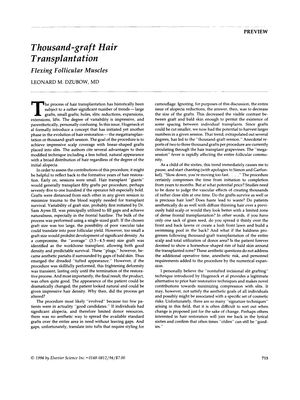Thousand-Graft Hair Transplantation
November 1994
in “
The Journal of Dermatologic Surgery and Oncology
”
hair transplantation thousand-graft sessions megatransplantation linear-shaped grafts slits tufted appearance vascular effects graft survival rate aesthetic outcomes operative time anesthetic risks hair transplant thousand-graft transplant mega transplant graft survival cosmetic outcomes surgery time anesthesia risks

TLDR Thousand-graft hair transplants offer better coverage and look more natural but have concerns about graft survival and cosmetic risks.
In the 1994 article, Leonard M. Dzubow, MD, discussed the evolution of hair transplantation techniques, focusing on the then-new concept of thousand-graft sessions, also known as megatransplantation. This method aimed to provide better scalp coverage and a more natural appearance by using linear-shaped grafts placed into slits. Dzubow reflected on the history of hair transplantation, noting that early sessions involved fewer grafts and that the size of grafts was a compromise between achieving density and ensuring survival. He highlighted the problem of the "tufted appearance" when grafts were surrounded by bald skin, which could be mitigated by skillful execution of the procedure. The trend towards smaller grafts allowed for more grafts per session, leading to the thousand-graft sessions. However, Dzubow expressed concerns about the potential vascular effects of creating many slits at once, the survival rate of grafts, and the aesthetic outcomes, as well as the increased operative time, anesthetic risks, and personnel requirements. He acknowledged the contributions of the technique by Hugeneck et al but also suggested that it might not meet everyone's aesthetic goals and could carry cosmetic risks. Dzubow called for further studies and cautioned against change for the sake of change, suggesting that sometimes traditional methods could still be effective.
